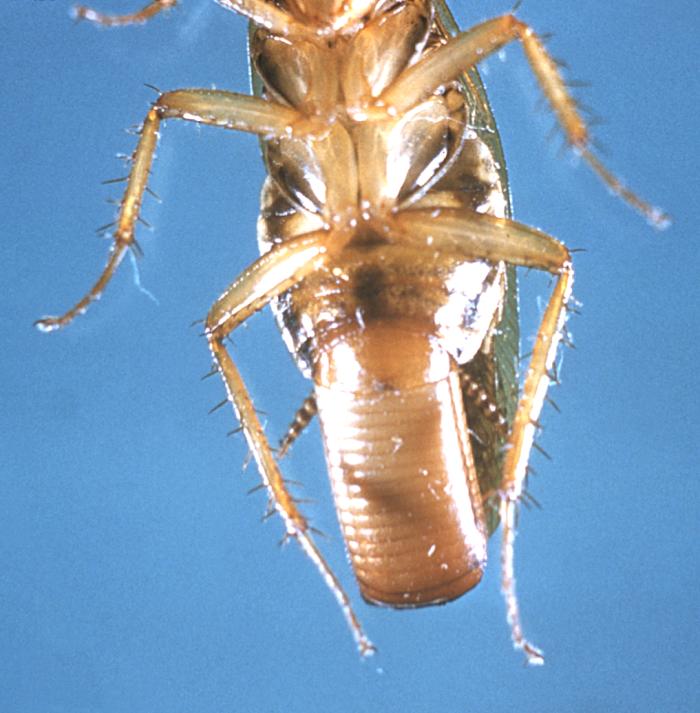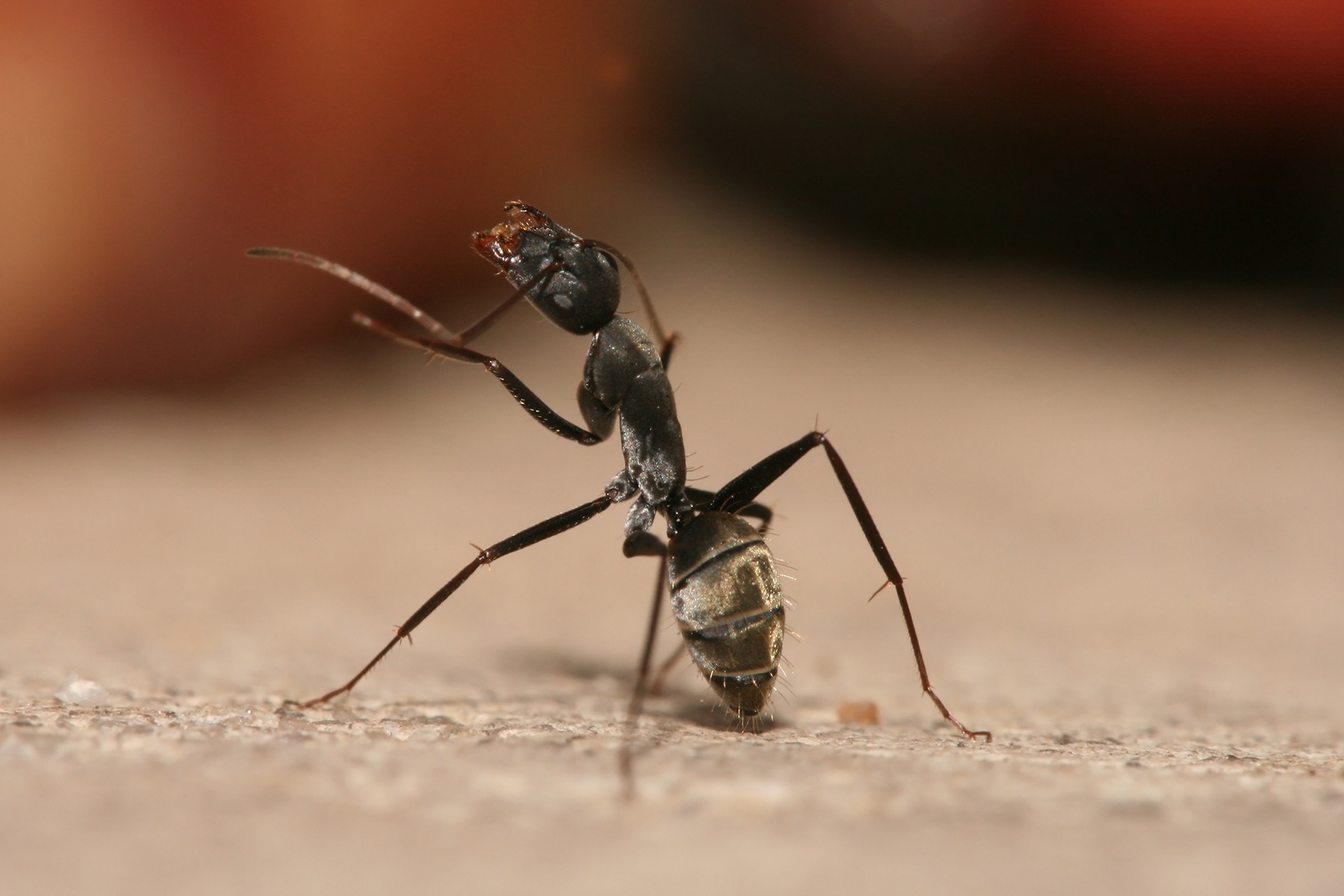|
Subgenual Organ
The subgenual organ is an organ in insects that is involved in the perception of sound. The name (Latin ''sub: "''below" and ''genus: "''knee") refers to the location of the organ just below the knee in the tibia of all legs in most insects. The function of the organ is performed by aggregations of scolopidia, the unit mechanoreceptor in invertebrates. The organ is thought to be an evolutionary artifact of ancestral insects who used their legs to detect vibrations in the underlying substrate. The anatomy and innervation of the organ is highly variable between species. However, the organ may be sensitive enough to detect less than 1 nm of displacement in the ground, and sometimes airborne sound waves. The sensitivity of the organ varies from species to species; in Orthoptera, Hymenoptera and Lepidoptera, sensitivity is on the order of one (or greater) kilohertz, while in Hemiptera sensitivity reaches only a few hundred hertz. Characteristics within orders * Lepidopte ... [...More Info...] [...Related Items...] OR: [Wikipedia] [Google] [Baidu] |
Semaphorin
Semaphorins are a class of secreted and membrane proteins that were originally identified as axonal growth cone guidance molecules. They primarily act as short-range inhibitory signals and signal through multimeric receptor complexes. Semaphorins are usually cues to deflect axons from inappropriate regions, especially important in the neural system development. The major class of proteins that act as their receptors are called plexins, with neuropilins as their co-receptors in many cases. The main receptors for semaphorins are plexins, which have established roles in regulating Rho-family GTPases. Recent work shows that plexins can also influence R-Ras, which, in turn, can regulate integrins. Such regulation is probably a common feature of semaphorin signalling and contributes substantially to our understanding of semaphorin biology. Every semaphorin is characterised by the expression of a specific region of about 500 amino acids called the sema domain. Semaphorins were named a ... [...More Info...] [...Related Items...] OR: [Wikipedia] [Google] [Baidu] |
Cuticle
A cuticle (), or cuticula, is any of a variety of tough but flexible, non-mineral outer coverings of an organism, or parts of an organism, that provide protection. Various types of "cuticle" are non- homologous, differing in their origin, structure, function, and chemical composition. Human anatomy In human anatomy, "cuticle" can refer to several structures, but it is used in general parlance, and even by medical professionals, to refer to the thickened layer of skin surrounding fingernails and toenails (the eponychium), and to refer to the superficial layer of overlapping cells covering the hair shaft ( cuticula pili), consisting of dead cells, that locks the hair into its follicle. It can also be used as a synonym for the epidermis, the outer layer of skin. Cuticle of invertebrates In zoology, the invertebrate cuticle or cuticula is a multi-layered structure outside the epidermis of many invertebrates, notably roundworms and arthropods, in which it forms an exoskeleton ... [...More Info...] [...Related Items...] OR: [Wikipedia] [Google] [Baidu] |
Blattella Germanica
The German cockroach (''Blattella germanica''), colloquially known as the croton bug, is a species of small cockroach, typically about long. In color it varies from tan to almost black, and it has two dark, roughly parallel, streaks on the pronotum running anteroposteriorly from behind the head to the base of the wings. Although ''B. germanica'' has wings, it can barely fly, although it may glide when disturbed. Of the few species of cockroach that are domestic pests, it probably is the most widely troublesome example. It is very closely related to the Asian cockroach, and to the casual observer, the two appear nearly identical and may be mistaken for each other. However, the Asian cockroach is attracted to light and can fly like a moth, while the German cockroach cannot. Biology and pest status The German cockroach occurs widely in human buildings, but is particularly associated with restaurants, food processing facilities, hotels, and institutional establishments such as ... [...More Info...] [...Related Items...] OR: [Wikipedia] [Google] [Baidu] |
Blaberus Discoidalis
''Blaberus discoidalis'', commonly known as the discoid cockroach, tropical cockroach, West Indian leaf cockroach, false death's head cockroach, Haitian cockroach, and drummer, is a cockroach native to Central America of the “giant cockroach” family, Blaberidae. The adult is around in length, and is tan with a dark brown to black patch on its pronotum. The juvenile is brown with tan speckles, and matures to adulthood in 4–5 months. Adults have wings but are not active fliers, and they can not climb smooth vertical surfaces, simplifying their care in captivity. ''Blaberus discoidalis'' is called the false death's head cockroach because of its superficial resemblance to the death's head cockroach, ''Blaberus craniifer''. Distribution ''Blaberus discoidalis'' is found in Jamaica, Cuba, Hispaniola, Puerto Rico, Puerto Rico (Vieques Island), Panama, Colombia, Venezuela, Trinidad and Tobago, and Florida. Locomotion The movement of ''B. discoidalis'' runs relatively ineffici ... [...More Info...] [...Related Items...] OR: [Wikipedia] [Google] [Baidu] |
Cochlea
The cochlea is the part of the inner ear involved in hearing. It is a spiral-shaped cavity in the bony labyrinth, in humans making 2.75 turns around its axis, the modiolus. A core component of the cochlea is the Organ of Corti, the sensory organ of hearing, which is distributed along the partition separating the fluid chambers in the coiled tapered tube of the cochlea. The name cochlea derives . Structure The cochlea (plural is cochleae) is a spiraled, hollow, conical chamber of bone, in which waves propagate from the base (near the middle ear and the oval window) to the apex (the top or center of the spiral). The spiral canal of the cochlea is a section of the bony labyrinth of the inner ear that is approximately 30 mm long and makes 2 turns about the modiolus. The cochlear structures include: * Three ''scalae'' or chambers: ** the vestibular duct or ''scala vestibuli'' (containing perilymph), which lies superior to the cochlear duct and abuts the oval window ** the ty ... [...More Info...] [...Related Items...] OR: [Wikipedia] [Google] [Baidu] |
Periplaneta Americana
The american cockroach (''Periplaneta americana'') is the largest species of common cockroach, and often considered a pest. In certain regions of the U.S. it is colloquially known as the waterbug, though it is not a true waterbug since it is not aquatic. It is also known as the ship cockroach, kakerlac, and Bombay canary. It is often misidentified as a palmetto bug. Despite their name, American cockroaches are native to Africa and the Middle East. They are believed to have been introduced to the Americas only from the 17th century AD onward as a result of human commercial patterns, including the Atlantic slave trade The Atlantic slave trade, transatlantic slave trade, or Euro-American slave trade involved the transportation by slave traders of enslaved African people, mainly to the Americas. The slave trade regularly used the triangular trade route and i .... Distribution Despite the name, none of the ''Periplaneta'' species is native to the Americas; ''P. americana'' ... [...More Info...] [...Related Items...] OR: [Wikipedia] [Google] [Baidu] |
Zootermopsis Angusticollis
''Zootermopsis angusticollis'' is a species of termite (Isoptera) in the family Archotermopsidae, a group known as the dampwood termites, or the rottenwood termites. As their name suggests, the dampwood termites can only survive by living off of wood that contains high amounts of moisture. They are found along the wet environments of the Pacific coast of North America. Most are found in the states of California, Oregon, Washington, Idaho, Western Nevada and in southern British Columbia. Termites are well known to be destroyers of wood, and although the dampwood termites can cause some damage, they are not as notoriously known to cause as much damage to buildings as the drywood termites. They occasionally have been carried to other parts of the country through wood shipments, but have not been able to become established in these areas due to undesirable environmental conditions. Identification ''Z. angusticollis'' is a hemimetabolous, diploid species. Upon hatching from their egg ... [...More Info...] [...Related Items...] OR: [Wikipedia] [Google] [Baidu] |
Sensilla
A sensillum (plural ''sensilla'') is an arthropod sensory organ protruding from the cuticle of exoskeleton, or sometimes lying within or beneath it. Sensilla appear as small hairs or pegs over an individual's body. Inside each sensillum there are two to four sensory neurons. These neurons, or receptors, gather information about environment the arthropod is in: * Chemoreceptors (i.e. trichoid, basionic, coeloconic, placodea) * Mechanoreceptors (e.g.: bristle sensilla, campaniform sensilla, hair plates, chordotonal neurons) * Thermoreceptors * Hygroreceptors Most sensilla are specially shaped according to the type of information they are gathering. In spiders, slit sensilla are used to detect substrate vibrations, while trichobothria are used to detect air-borne vibrations. Chemoreceptors Chemo-reception is one of the most dominant senses in the insect kingdom. Many arthropods use chemical signals to locate food, shelter and mates. Other invertebrates have similar sensory ... [...More Info...] [...Related Items...] OR: [Wikipedia] [Google] [Baidu] |
Camponotus Ligniperda
''Camponotus ligniperda'', the brown-black carpenter ant, is a common species of carpenter ant distributed widely throughout Europe. Found in a variety of woodland habitats, they commonly nest on the ground in dry tree stumps, dead fallen trees, or beneath stones and wooden logs that are partially buried. ''C. ligniperda'' is an ecologically dominant species wherever it is found due to both its large size and particularly aggressive nature. Description ''Camponotus ligniperda'' is one of if not the largest extant ant species found in Europe, with queens reaching lengths of 16–18 mm (potentially 20 mm when physogastric) followed by 14–15 mm major workers. Intermediate and minor workers measure on average 7–10 mm. Individuals are typically bicolored with a black head and a reddish brown thorax which color bleeds into the legs and anterior segment of the dark colored gaster. Considered a sister species to ''Camponotus herculeanus'', the species can be distin ... [...More Info...] [...Related Items...] OR: [Wikipedia] [Google] [Baidu] |
Carpenter Ant
Carpenter ants (''Camponotus'' spp.) are large () ants indigenous to many forested parts of the world. They build nests inside wood consisting of galleries chewed out with their mandibles or jaws, preferably in dead, damp wood. However, unlike termites, they do not consume wood, discarding a material that resembles sawdust outside their nest. Sometimes, carpenter ants hollow out sections of trees. They also commonly infest wooden buildings and structures, and are a widespread problem and major cause of structural damage. Nevertheless, their ability to excavate wood helps in forest decomposition. The genus includes over 1,000 species. They also farm aphids. In their farming, the ants protect the aphids from predators (usually other insects) while they excrete a sugary fluid called honeydew, which the ants get by stroking the aphids with their antennae. Description ''Camponotus'' are generally large ants, with workers being 4-7 mm long in small species or 7-13 mm in large spe ... [...More Info...] [...Related Items...] OR: [Wikipedia] [Google] [Baidu] |
Vestibular System
The vestibular system, in vertebrates, is a sensory system that creates the sense of balance and spatial orientation for the purpose of coordinating movement with balance. Together with the cochlea, a part of the auditory system, it constitutes the labyrinth of the inner ear in most mammals. As movements consist of rotations and translations, the vestibular system comprises two components: the semicircular canals, which indicate rotational movements; and the otoliths, which indicate linear accelerations. The vestibular system sends signals primarily to the neural structures that control eye movement; these provide the anatomical basis of the vestibulo-ocular reflex, which is required for clear vision. Signals are also sent to the muscles that keep an animal upright and in general control posture; these provide the anatomical means required to enable an animal to maintain its desired position in space. The brain uses information from the vestibular system in the head and fro ... [...More Info...] [...Related Items...] OR: [Wikipedia] [Google] [Baidu] |






